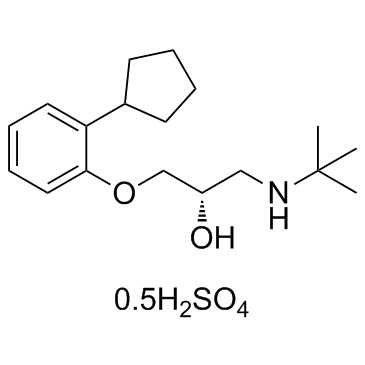Penbutolol sulfate

Penbutolol sulfate structure
|
Common Name | Penbutolol sulfate | ||
|---|---|---|---|---|
| CAS Number | 38363-32-5 | Molecular Weight | 340.47 | |
| Density | N/A | Boiling Point | 438.2ºC at 760mmHg | |
| Molecular Formula | C18H29NO2.1/2H2O4S | Melting Point | 216-218℃ (Decomposition) | |
| MSDS | N/A | Flash Point | 218.8ºC | |
|
5-HT receptor subtypes involved in the spinal antinociceptive effect of acetaminophen in rats.
Eur. J. Pharmacol. 432(1) , 1-7, (2001) The present study was designed to investigate which subtype of spinal 5-HT receptors were involved in acetaminophen-induced antinociception using the paw-pressure test. Propacetamol (prodrug of acetaminophen, 400 mg/kg, injected intravenously, corresponding t... |
|
|
Autoreceptors remain functional after prolonged treatment with a serotonin reuptake inhibitor.
Brain Res. 835(2) , 224-8, (1999) Serotonin (5-hydroxytryptamine, 5-HT) autoreceptors may desensitize during prolonged administration of antidepressant drugs. If autoreceptors desensitize, their inhibitory influence on extracellular 5-HT should be attenuated. To test this hypothesis, the sele... |
|
|
Affinity of (+/-)-pindolol, (-)-penbutolol, and (-)-tertatolol for pre- and postsynaptic serotonin 5-HT(1A) receptors in human and rat brain.
J. Neurochem. 75(2) , 755-62, (2000) There is considerable interest in the use of drugs that selectively block presynaptic (somatodendritic) serotonin 5-HT(1A) receptors for the adjunctive treatment of major depressive disorder. The 5-HT(1A)/beta-adrenoceptor ligands (+/-)-pindolol, (-)-tertatol... |
|
|
The antiaggressive potency of (-)-penbutolol involves both 5-HT1A and 5-HT1B receptors and beta-adrenoceptors.
Eur. J. Pharmacol. 297(1-2) , 1-8, (1996) The relative importance of 5-HT1A and beta-adrenergic activities in the antiaggressive effects of (-)-penbutolol was studied in male mice. (-)-Penbutolol had high affinity for 5-HT1A receptors and beta-adrenoceptors, and antagonized the 5-methoxy-N,N-dimethyl... |
|
|
High-performance liquid chromatography with chemiluminescence detection of penbutolol and its hydroxylated metabolite in rat plasma.
J. Chromatogr. B. Biomed. Sci. Appl. 757(2) , 229-35, (2001) This paper describes a new method of high-performance liquid chromatography with chemiluminescence detection for the analysis of penbutolol (PB) and its main metabolite, 4-hydroxy penbutolol (4-OH PB) in rat plasma. 4-Dimethylaminosulfonyl-7-(N-chloroformylme... |
|
|
Interaction studies of 5-HT1A receptor antagonists and selective 5-HT reuptake inhibitors in isolated aggressive mice.
Eur. J. Pharmacol. 334(2-3) , 127-32, (1997) Recently published studies have suggested that behavioral and neurochemical changes induced by selective serotonin (5-hydroxytryptamine, 5-HT) reuptake inhibitors are potentiated by coadministration of a 5-HT1A receptor antagonist. The potentiating effect is ... |
|
|
Design and synthesis of new potent, silent 5-HT1A antagonists by covalent coupling of aminopropanol derivatives with selective serotonin reuptake inhibitors.
Bioorg. Med. Chem. Lett. 8(23) , 3423-8, (1998) Hybrid molecules built up by covalent coupling of aminopropanol derivatives (especially pindolol) with antidepressant drugs like fluoxetine, paroxetine or milnacipran were found to be potent and silent 5-HT1A antagonists (KB < 1 nM for 7c and 9a). |
|
|
Decrease in penbutolol protein binding as a consequence of treatment with some alkylating agents.
Cancer Chemother. Pharmacol. 34(1) , 86-8, (1994) The effect of in vitro treatment of serum with the alkylating agents carmustine (BCNU) and mechlorethamine on the protein binding of penbutolol, a basic agent mainly bound to alpha 1-acid glycoprotein (AAG), was investigated. The free fraction of penbutolol i... |
|
|
In vitro transdermal iontophoretic delivery of penbutolol sulfate.
Drug Deliv. 16(1) , 11-4, (2009) Iontophoretic transport of penbutolol sulfate across porcine ear skin was studied. Passive transdermal flux of the drug in phosphate-buffered saline was 7.65 microg/cm(2) hr. There was statistically significant flux enhancement when direct current iontophores... |
|
|
Unchanged protein binding of penbutolol in renal insufficiency: a possible role of carbamylation.
Int. J. Clin. Pharmacol. Ther. Toxicol. 31(1) , 31-4, (1993) The effect of in vitro carbamylation of serum protein with potassium cyanate on protein binding of penbutolol, a basic agent exclusively bound to alpha 1 acid glycoprotein (AAG), was investigated. Carbamylation of serum resulted in a weak increase on free fra... |